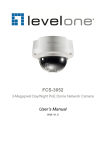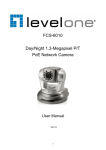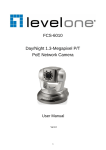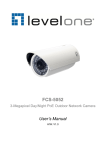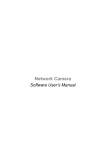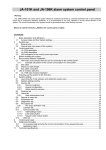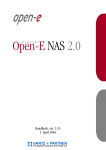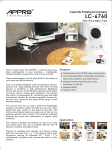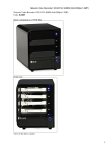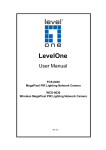Download um_NetworkCamera_EN_20110328 (1)
Transcript
Megapixel Network Camera User Manual Quality Service Group Product name: Network Camera Release Date: 2011/01 Manual Revision: V1.3 - - Table of Contents Package Contents............................................................................................ 0 Installation ...................................................................................................... 1 System Requirements .......................................................................................................1 Software Installation ..........................................................................................................2 IP Utility ............................................................................................. 6 Authentication....................................................................................................................8 Installing the Plug-In..........................................................................................................9 Live View ...................................................................................................... 10 Configuration ............................................................................................... 13 Camera/Video/Audio ........................................................................................................ 13 Camera ............................................................................................ 13 Video ............................................................................................... 16 Audio Configuration .............................................................................. 19 Multicast .......................................................................................... 20 Privacy Mask Control(*) ....................................................................... 21 Network ............................................................................................................................ 22 IP Settings ........................................................................................ 22 UPnP ............................................................................................... 23 DDNS (dynamic domain name service) ...................................................... 24 HTTP/HTTPS ..................................................................................... 25 Wireless (*) ........................................................................................................................ 28 Basic Settings(*) .................................................................................. 28 Advanced Settings(*) ............................................................................ 32 Wi-Fi Protected Setup(*) ........................................................................ 33 Event ................................................................................................................................. 34 Motion Detection ................................................................................ 34 DI/DO(*) ............................................................................................ 35 PIR (*) .............................................................................................. 36 Notifications ..................................................................................................................... 37 Notification Settings ........................................................................... 37 FTP Settings...................................................................................... 38 SMTP Settings ................................................................................... 39 Samba Settings .................................................................................. 40 HTTP Settings.................................................................................... 41 Audio Clip(*) ...................................................................................... 42 Video Clip(*) ...................................................................................... 42 SD card(*) ................................................................................................ ................................ .......................................................... 43 Scheduled Event(*) ................................................................ ............................................................................. 43 Storage Management ment (*) ................................................................ ....................................... 45 Maintenance ................................................................................................ ................................ ..................................................... 47 Language ......................................................................................... ................................ ......................... 47 User Management................................................................ ............................................................................... 47 IP Filter ............................................................................................ ................................ ............................ 49 Firmware Upgrade ................................................................ .............................................................................. 49 Configuration ................................................................ .................................................................................... 49 Reset to Default ................................................................ ................................................................................. 50 Reboot ............................................................................................. ................................ ............................. 50 System .............................................................................................................................. ................................ .............................. 51 System Log ....................................................................................... ................................ ....................... 51 Date and Time................................................................ .................................................................................... 52 Save File Folder ................................................................ ................................................................................. 53 Device Information ................................................................ ............................................................................. 53 Appendix A. Comparison Datasheet For Different Product Series: .................................. ................................ 55 NOTE - (*) The features that are available for this product are optional. They are not supported by the economy model. - - Package Contents Please check to make sure the product package contains all of the accessories listed below. ♦ ♦ IP Camera Product CD ♦ ♦ ♦ ♦ Camera Stand White Flat RJ-45 cable(1.5m) Warranty Card Power Adapter Installation System Requirements Operating System: Microsoft Windows XP Home Edition SP2 Microsoft Windows XP Professional SP2 Computer: IBM PC/AT Compatible CPU: Pentium 3GHz or faster Memory: 1024 MB or more Monitor: 1024 x 768 pixels or more, 24-bit True color or better Network Interface: 10/100Mbps Network interface card must be installed Web Browser: Microsoft Internet Explorer 6.0 SP2 or higher Adobe Reader: Adobe Reader 8.0 or higher Audio: The audio function will not work if a sound card is not installed in the PC. Audio may be interrupted depending on network traffic. -1- Software Installation In this manual, "User" refers to whoever has access to the Network Camera, and "Administrator" refers to the person who can configure the camera and grant user access to the camera. After checking the hardware connection, run the Installation Wizard program included on the product’s CDROM to automatically search the intranet for the camera. There may be many cameras on the local network. Differentiate the cameras using the serial number which is printed on the labels on the carton and on the bottom of the camera. 1. Insert the Installation CD into the CD-ROM driver. Run the Auto-Run Tool directly from the CD-ROM to start the installation. When installing the Network Camera Toolkit for the first time, select a desired language for the interface. The available languages are listed in the scroll box. Click <Install IP Utility> or <Install PC-NVR> to install. If installing the PC-NVR program, please refer to the PC-NVR user manual. If installing the IP Utility, follow the steps to install the IP Utility wizard on the desired computer. -2- 2. In the Install Shield Wizard dialog box, click <Next> to continue. 3. Click <Change> to change the folder where installation and program files will be stored. Click <Next> to continue. -3- 4. Select to create shortcuts. Click <Next> to continue. -4- 5. Click to launch the application, and click <Finish> to complete the installation. -5- IP Utility To launch the IP Utility, an IP Utility icon was installed on the desktop. Double click on the icon to open. The program can also be found in C:\Program Files\NetworkCamera\IP Utility unless the program was saved to a preferred directory. 1. Click <Start> to continue. The program will automatically search for the camera on the intranet. -6- 2. There may be many cameras on the local network. Differentiate the cameras by using their UPnP name. Double click on the camera from the survey list to connect. -7- Authentication To access the camera’s live view, open a web browser and enter the IP address of the camera. A dialog window will pop requesting a username and password. The default username and password for the Administrator are assigned as “admin/admin”. For non administratoraccounts, users can choose to remember the password for future convenience. However, It is not recommended that this feature be used public computer. -8- when viewing the camera from a Installing the Plug-In Plug For initial access to the camera in Windows, the web browser may ask the administrator for permission to install a new plug-in plug for Internet Explorer.. Permission request depends on the Internet security settings of the user’s PC or notebook. If the highest security level is set, the th computer may prohibit any attempt to install or run the program.. This plug-in plug has been certified and is used to display the video in the browser. Click on to proceed. If the web browser does not allow the administrator to continue the installation, check ch the Internet security options and lower the security levels or contact the network supervisor or IT for help. (1) NOTE – After upgrading firmware of the camera, ifi an error occurred or the plug-in in fails to install. install Please refer to the following steps:Remove the “NetworkCamera NetworkCamera Media Control Embedded”” via the path “Control Table”->”Add/Remove program”. (2) Restart the computer. (3) Connect to the camera (4) Install the permission again. -9- Live View Live View is the default page that opens when accessing the camera. Live video is displayed directly in the window browser. Stream1/Stream2 Channels The network camera offers simultaneous dual stream for optimized quality and bandwidth. Go to Configuration → Camera/Video/Audio → Video to configure the codec compression and video resolution or refer to the Video configuration page. - 10 - HTTP/TCP/UDP protocol HTTP – This unicast method can be used to traverse firewalls. Firewalls are commonly configured to allow the HTTP protocol, thus allowing RTP to be tunneled. TCP - This protocol guarantees the complete delivery of streaming data and provides better video quality. The downside of using this protocol is that the quality of its real-time real effect is less than that of the UDP protocol. UDP - This protocol allows for more mor real-time time audio and video streams. However, network packets may be lost due to network traffic and images may be broken. Activate UDP connection time - sensitive responses are more important than video quality. (*) LED Control – Use the drop-down drop menu to adjust the brightness of the camera’s LED. / Recording on/off - Displays the status of recording video / MIC on/off - Displays the status of the MIC volume / / Speaker on/off - Displays the status of the Speaker volume MD on/off - Displays the status of Motion Detection Play or Stop - Play or stop the video. Record - Record ecord video to a computer. Snapshot - Capture apture and save still images. Digital Zoom - Enable nable the digital zoom operation. Mirror - Horizontally orizontally reflect the display of the live video. Flip - Vertically ertically reflect the display of the live video. Size - View the object in real size. Click again to switch back to normal mode. Full Screen - Switch witch to full screen mode. Press the “Esc” key to return to normal mode. - 11 - Motion Detection - Enable nable the motion detection alert function. Mute – Turn off the sound. Talk – Communicate ommunicate through the camera using the computer MIC. Default – Reset to default. Brightness - Drag the slider bar to adjust the image brightness. Mic volume - Drag the slider bar to adjust the microphone volume. Speaker volume - The built-in speaker will play sound from an audio clip from the computer microphone when it is enabled. For more Audio settings, ettings, please refer refer to the Audio configuration page. page NOTE 1. The <Control Panel> functions have no effect on the recorded video. Whatever changes are made to the <Control Panel> > will not be applied to the recorded video. 2. The LED is not for continuous use and has an estimated life span of 30,000 hours. 3. The LED cannot be replaced. - 12 - Configuration Click <Configuration> on n the top right corner of the main page to make changes to the camera settings. Please refer to Appendix Appen A “Comparison datasheet for different product series” for further comparison. NOTE - Only nly Administrators can access the Configuration page. Camera/Video/Audio Camera ag the slider bar to adjust the image brightness level l from -5 to +5. Brightness - Drag Contrast - Drag the slider bar to adjust the image contrast level from -5 to +5. - 13 - Sharpness - Drag the slider bar to adjust the image sharpness level from -5 to +5. Saturation - Drag the slider bar to adjust the image saturation level from -5 to +5. Exposure Control Sport – Select this option when wh monitoring rapidly moving objects. Normal – Select this option for normal monitoring conditions. Night Vision – Select this option when when monitoring at night or in low light conditions. User Defined – Select this option to define the exposure manually. AGC (Auto Gain Control) - The AGC can be set from 1X to 5X. Set the Gain Rate higher for better video illumination. illumination 5X provides the best video illumination. Shutter Speed Fast – For high activity exposure. Normal – For normal exposure. Slow – For night vision exposure. AE Lock (Auto Exposure) - The camera will automatically adjust the exposure to changes in ambient light. ligh NOTE – A higher gain rate may cause fast moving images to judder or blur. - 14 - Mirror and Flip Mirror - Enable to horizontally reflect the display of the live video. Flip - Enable to vertically reflect the display of the live video. Flicker-Free – Eliminate the problem of flicker. Click the Radio button to select outdoor or indoor mode based on the conditions. Color Effect - Select to display color or black and white video streams. Click Apply to apply settings or Cancel to cancel changes. - 15 - Video The Network Camera offers two separate streams for different viewing options. Stream 1 & Stream 2 Video Codec - The Network Camera offers three choices of video codec standards for real-time viewing: H.264, MPEG-4 and MJPEG. Video Resolution - Select from the drop-down menu to choose the best resolution recording settings. Frame Rate - Select the frame rate from drop-down menu. When H.264 or MJPEG or MPEG-4 is selected, the frame rate ranges from 1 to 15 fps. Set a higher frame rate for smoother video quality. Video quality and bitrate - Choose either “quality” or “bitrate” to control the video quality with H.264 or MPEG4. Only “quality” can be chosen when MJPEG is selected. bitrate higher for better video quality. - 16 - Set the NOTE - a higher bitrate will use upmore network bandwidth. The video quality can be set between Level 1 to Level 6, with Level 6 producing the best image quality. Quick Settings: For Mobile Streaming – Click to adjust the video codec to MPEG4 with 320x192 (QVGA) resolutions for the video that can be viewed in mobile phone. HTTP Transport – If MJPEG is used for Video Codec, users can enable HTTP Transport protocol for video communication. NOTE – HTTP Transport is for non-IE non browser users only. Video Overlay Timestamp To display the date and time on the screen during live view, check to enable the timestamp function and select the display position from the drop-down drop down menu. Text To make a note about the camera, check to enable and select the display position from the drop-down down menu. Enter a video description in the text box. Click Apply to apply settings or Cancel to cancel changes. NOTE - The video overlay will wil only take effect in stream 1. - 17 - RTSP Server To utilize RTSP authentication, the user must first set a password for the camera. RTSP (Real-Time Streaming Protocol) controls the delivery of streaming media. By default the port number is set to 554. Authentication - Depending on the network security requirements, the camera provides two types of security settings for streaming via RTSP protocol: NONE and DIGEST. If DIGEST authentication is selected, user credentials are encrypted using MD5 algorithm, thus providing better protection against unauthorized access. Click Apply to apply settings or Cancel to cancel changes. - 18 - Audio Configuration The administrator can set up two separate streams for the camera for different viewing devices. The administrator can enable or disable the audio function on either stream. If audio enable is selected, select the Audio codec from the drop-down menu. Advanced Settings(*) Camera MIC (*) - The Network Camera supports two way audio communication so that operators can transmit and receive audio simultaneously. By using the Network Camera’s built-in microphone and an external speaker, users can communicate with people who are within range of the Network Camera. Camera Speaker (*) – If the speaker is enabled, select the volume from the drop-down menu. Echo Cancellation (*) - Enable to avoid echo. Click Apply to apply settings or Cancel to cancel changes. - 19 - Multicast Multicast sends a video stream to the multicast group address and allows multiple clients to access the stream at the same time by requesting a copy from the multicast group address. Therefore, multicast can effectively save Internet bandwidth. The RTSP (Real-Time (Real Streaming Protocol) controls the delivery of streaming media. Click “Enable” to enable Multicast Multicast stream 1 or Multicast stream 2. The default value for the multicast address and port are 234.1.2.3 and 10000. Use different port numbers number for different streams. It is recommended to use the default values. NOTE - Using the IP address of the Network Camera enabless access to the video. Example: rtsp://192.168.1.1/channel1(Not rtsp://192.168.1.1/channel1 supported by IE, Windows media player. p It is recommended to use: VLC media player) player Click Apply to apply settings or Cancel to cancel changes. - 20 - Privacy Mask Control(*) The Cube camera is equipped with a privacy feature which allows users to mask the camera’s live view. A black screen will be displayed in the place of the live view window. This application is particularly useful when the camera is being used for home surveillance. With the privacy button, users can have privacy while they are going about their daily life. Privacy Mask Control(*) – Enable the Privacy Mask control to remotely mask the camera’s live view. Hardware Privacy Mask Button(*) *) – Click to enable the privacy mask button on the camera. If this feature is not enabled, the user will not be able to use the privacy mask button. Click Apply to apply settings or Cancel to cancel changes. - 21 - Network IP Settings This section explains how to configure a wired network connection for the camera. There are several ways to setup the camera over the Internet: (1) obtain an available dynamic IP address assigned by a DHCP server, (2) use a static IP address, or (3) use PPPoE (Point-to-point over Ethernet). Select the desired setup mode from the IP settings drop-down menu. 1. DHCP – If this option is selected, the camera will automatically obtain an available dynamic IP address from the DHCP server each time it connects to the LAN. Click Apply to apply settings or Cancel to cancel changes. 2. Static IP - Select this option to manually assign a static IP address to the camera. Enter the static IP address, Subnet mask, Default Gateway, and Primary and Secondary DNS provided by the ISP. Click Apply to apply settings or Cancel to cancel changes. - 22 - 3. PPPoE (Point-to-point point over Ethernet): Ethernet) Use this mode if connecting to the Internet through a DSL Line. NOTE – This feature requires an account provided by an Internet Service Provider. Enter the user name and password provided by the ISP. Click Apply to apply settings or Cancel to cancel changes. UPnP Universal Plug and Play (UPnP) simplifies the process of adding a camera to a local area network. Once connected to a LAN, the camera will automatically appear on the intranet. Click to enable this function and enter an UPnP name that the camera will appear as on the intranet. Click Apply to apply settings or Cancel to cancel changes. - 23 - DDNS (dynamic domain name service) DDNS links a domain name to an IP address, allowing users to easily access their camera even with a changing IP address. The network cameras ameras are compatible with two DDNS service providers (1)) DynDNS, and (2) TZO. TZO NOTE - Before utilizing this function, function please apply for a dynamic domain account from a DDNS provider. DynDNS – Enable nable the DynDNS to give the camera a fixed host and domain name. Refer to the DynDNS website (www.dyndns.com) to apply for a dynamic domain account. When an account has been created, enter the username, password and hostname. TZO is a DDNS provider that allows users to create a dynamic DNS. Refer R to the TZO website (http://www.tzo.com/) to apply appl for a dynamic namic domain account. When an account has been created, enter the e-mail mail address, password and domain name. Click Apply to apply settings or Cancel to cancel changes. - 24 - HTTP/HTTPS HTTP – (HyperText Transfer Protocol) - This protocol allows for TCP protocol quality without having to open specific ports for streaming. Users inside a firewall can utilize this protocol to allow data to stream through.. HTTPS - (Hypertext Transfer Protocol over SSL) - This protocol allows authentication and encrypted communication over SSL (Secure Socket Layer). It helps protect streaming data transmission over the Internet on a higher security level than HTTP. Click “Enable” to enable and Apply to apply settings or Cancel to cancel changes. - 25 - To enable HTTPS, users have to create and install a certificate. 1. Click “Continue to this website” to install. 2. Enter the User name and Password of the camera. - 26 - 3. Click “Certificate Error” on the top right corner of the window to view the certificate. 4. Click “Install Certificate” and follow the steps to finish the installation. - 27 - Wireless (*) These settings control how a Network Camera interacts with a wireless network. Users can identify the wireless network and enable wireless encryption. NOTE – This function is only available for Wi-Fi models. Basic Settings(*) Network Name (SSID) - The Service Set Identifier (SSID) is the network name used to identify the wireless signal emitted from a wireless camera. It is case-sensitive sensitive and can be up to 32 characters long. Wireless devices have a default SSID set by the factory. NetworkCamera wireless products use NetworkCamera as the default name. It is recommended that users rename their SSID to something omething unique in order to distinguish their wireless device from surrounding wireless networks. NOTE - Be careful when including personal information when naming the SSID as it can - 28 - be viewed by anyone browsing for wireless networks. Security - Encryption protects data transmitted over a wireless network. Wi-Fi Protected Access (WPA-Personal/WPA2-personal) and Wired Equivalent Privacy (WEP) offer different levels of security for wireless communication. A network encrypted with WPA-Personal/WPA2-personal is more secure than a network encrypted with WEP because WPA-Personal/WPA2-personal uses dynamic key encryption. To protect the information as it passes through the airwaves, it is recommended that the highest level of encryption supported by the network equipment be enabled. Site Survey – Survey the local area for available wireless networks. The user should select their Local Area Network (LAN) from the Site Survey List. Click Apply to apply settings or Cancel to cancel changes. WEP- Wired Equivalent Privacy (WEP) is a basic encryption method that transmits network broadcast messages using radio signals. It is not as secure as WPA. Tx Key - Select a key from the drop-down menu. WEP Encryption - Select a level of WEP encryption: 64 bits 10 hex digits or 128 bits 26 hex digits. The default is 64 bits 10 hex digits. - 29 - Key 1-4 - Enter the WEP key(s) manually. Authentication - The default is set to Open System, which allows either Shared Key or Auto authentication to be used. With Shared Key authentication, the sender and recipient use a WEP key for authentication. With Auto authentication, the sender and the recipient do not use a WEP key for authentication. Click Apply to apply settings or Cancel to cancel changes. WPA-Personal - WiFi Protected Access (WPA)-Personal Encryption - Supports two encryption methods with dynamic encryption keys: Temporal Key Integrity Protocol (TKIP) and Advanced Encryption Standard (AES). Select the algorithm type from the drop down menu: TKIP or AES. The default is TKIP. Shared Key - Enter the key shared between the Router and the server keys. Enter a password of 8-63 characters. Click Apply to apply settings or Cancel to cancel changes. - 30 - WPA2-Persona l - WiFi Protected Access (WPA2-Personal) (WPA2 Encryption - WPA2 supports AES encryption method with dynamic encryption keys. Shared Key - Enter the key shared between the Router and the server keys. keys Enter a password of 8-63 characters. Click Apply to apply settings or Cancel to cancel changes. NOTE - If using WPA or WPA2, each device in i the wireless eless network must use the same WPA or WPA2 method and shared key or else the network will not function properly. - 31 - Advanced Settings(*) Action – Click to enable or disable the function. Network Mode - From the drop-down menu, select the wireless standard running on the network. • If there are Wireless-B, Wireless-G and Wireless-N (2.4GHz) devices on the network, use the default setting, BGN-Mixed. • If there are Wireless-B and Wireless-G devices on the network, select BG-Mixed. • If there are only Wireless-B devices on the network, select Wireless-B Only. • If there are only Wireless-G devices on the network, select Wireless-G Only. • If there are only Wireless-N (2.4GHz) devices on the network, select Wireless-N Only. Radio Band - The settings are available for the Auto-20/40MHz channel and Standard-20 MHz channel. WMM (802.1e QoS) - WMM is a wireless Quality of Service feature that improves quality for audio, video, and voice applications by prioritizing wireless traffic. To use this feature, the wireless client devices on the network must support Wireless WMM. The default setting is Enable. To disable this feature, select Disable. Click Apply to apply settings or Cancel to cancel changes - 32 - Wi-Fi Protected Setup(*) Use this method if the client device has a Wi-Fi Protected Setup PIN number. 1. Enter the network name from the device in the field. 2. Click <Register> to start WPS. Click Apply to apply settings or Cancel to cancel changes. - 33 - Event Motion Detection Motion can be detected by measuring changes in the speed or vector of an object or objects in the monitored area. This section explains how to configure the Network Camera to enable motion detection. - 34 - Use this setting to enable and define the motion detection windows. The user can define up to three areas on the live view window for motion detection. 1. Select <Window1>, <Window2>, or <Window3> to adjust the motion detection window. 2. Check the box to enable the window. 3. Use the mouse to resize or move the motion detection window. 4. Adjust the “Sensitivity” level. Lower sensitivity levels will result in more activity needed to trigger an event. 5. Users can use this feature as a trigger source to send photos or videos to a remote server via email or FTP. Click Apply to apply settings or Cancel to cancel changes. DI/DO(*) The photo above shows how to modify the digital input and digital output. If the current status is set to high, when an event occurs, the digital output will send a notification to the user depending on the notification settings. - 35 - PIR (*) PIR Settings - The PIR (Passive InfraRed) sensor measures infrared light radiating from objects in its field of view. This can be used to detect a moving object, such as a person, in dimly lit areas. Enable and adjust the sensitivity of the PIR Sensor from the drop down menu. The sensitivity can be set from 10 - 100%; with the default sensitivity set at 50%. Higher sensitivity levels will increase the range of the PIR Sensor. When the sensitivity level is set to 100%, the PIR sensor will be able to detect moving objects within six meters. LED Control LED Control - select “Keep active during event” or “Keep active for” a specific amount of time when an event occurs. Light - The LED on the front of the camera can be set to flash at a configurable interval when an event is triggered. From the Activate drop down menu, select a percentage level for the LED to brighten to. When the LED reaches the selected percentage, it can be configured to fade off or to turn off immediately. Select the option from the Inactive menu. Click Apply to apply settings or Cancel to cancel changes. - 36 - Notifications Notifications are the reactions that occur in response to particular events. Users can set their notifications up so that when motion is detected, the Network Camera sends buffered images to an FTP server, Samba, SMTP, HTTP or an audio clip can be played. played In this page, you can specify which notification messages will be sent when a trigger trigger is activated. Notification Settings When an event is triggered, you can specify what kind of action will be performed. You can attach a video clip or snapshot to your email address, FTP site, and samba or use URL to send HTTP requests as the notification. notification NOTE - Refer to the Audio Clip section for more details about about the “Play Audio Clip.” Click Apply to apply settings or Cancel to cancel changes. - 37 - FTP Settings File Transfer Protocol (FTP) is used as an application component to automatically transfer files for a programa internal functions. Select “Primary FTP Server” from the Server Selection drop down menu to send media files to a FTP server when an event is triggered. Enter the FTP IP address or hostname. By default, the FTP port server is set to 21. Enter the account nameand password to configure the settings. There are two choices of media types available; video clip and Snapshot. Click Apply to apply settings or Cancel to cancel changes. - 38 - SMTP Settings Select to send the media files via Email when a trigger is activated. From - Enter the email address of the sender. To - Enter the email address of the recipient. Multiple recipients should be separated by commas. My name - The title shown in the email. Subject - Enter the subject of the email. Attachment - There are two choices of media types available; video Clip and Snapshot. SMTP Server and port number - Enter the server host name and port number of the email server. Authentication - Select the authentication type from the drop-down menu. Email Account - Enter the user name of the email account if necessary. Email Password - Enter the password of the email account if necessary. Click Apply to apply settings or Cancel to cancel changes. - 39 - Samba Settings Select this option to send the media files via a network neighborhood when an event is triggered. Server Address - Enter the IP address of the Samba server. User Name - Enter the user name of the Samba server. Password - Enter the password of the Samba server. WorkGroup - Enter the workgroup of the Samba server. Shared Folder - Enter the shared folder of the Samba server. Attachment - There are two choices of media types available; video Clip and Snapshot. Click Apply to apply settings or Cancel to cancel changes. - 40 - HTTP Settings Select this option to send the media files via an HTTP notification when an event is triggered. URL –Specify the URL to send HTTP requests. The URL is normally written as: http://ip_address/ notification.cgi?parameter ip_address – type the IP address or host name of the HTTP host. Parameter – type the notification parameter if necessary. Example URL - http://192.168.1.1/xxxx.cgi Message - name1=value1&name2=vlaue2 Result - http://192.168.1.1/xxxx.cgi? name1=value1&name2=vlaue2 Ex: https://192.168.1.1/notification.cgi?event=MD&camera=C1100 Message - Enter the message notification that will be sent when an event is triggered. Enter the user name and password if necessary. Click Apply to apply settings or Cancel to cancel changes. - 41 - Audio Clip(*) Audio clips can be recording and played when an event occurs. To record a new clip using the camera's microphone: 1. File Name - Enter a file name. 2. Duration - Enter the number of recording seconds. 3. Click Record to record the new audio clip. 4. The new audio clip will appear on the audio clip list. 5. Select an audio clip file from the Audio Clip List. a. Play- Select to hear the audio clip b. Stop- Select to stop playing the audio clip. c. Delete- Select to delete an audio clip. Video Clip(*) Video Clip can adjust the recording time and maximum buffer size before and after the event. - 42 - For example, if you set Pre-Alarm Buffer=5 seconds, the camera will record video 5 seconds before the motion was detected. 1. Pre-Alarm Buffer-The number of seconds recorded before detecting the event. 2. Post-Alarm Buffer-The number of seconds recorded after detecting the event. 3. Maximum Buffer Size-The Maximum Size used per recording. SD card(*) Scheduled Event(*) Click New to open the recording setting page. On this page, you can define the recording schedule and recording capacity. Select Enable; the system begins recording and sends recorded files to the Network Storage. Name - Enter a descriptive name for the recording setting. Record - Select from the drop-down menu for the recording event Time - Specify the recording duration. ■ Select the recording time in a 24-hr time format. - 43 - ■ Select the days on a weekly basis. When complete, Click Add to have the recording name appear on the recording list on the recording page. To edit a recording setting; click Edit to modify. Upon completion, click update to finish the modification. To remove a recording setting from the list, select a recording name from the list and click Delete. Click New to add more events. - 44 - Storage Management (*) Storage Management is used to view all of the recorded files on the (Micro)-SD/SDHC card. Click Reload to refresh the list of recorded files. Click Remove to safely remove the storage device. Select a folder to list the recorded files. Select a file and click Delete to delete the recorded file. Select a file and click Download to save the file in the desired folder. - 45 - Automatic Recycle – Enable to automatically overwrite old files when the available space remaining on the (Micro)-SD/SDHC card is less than 100MB. If the Automatic Recycle function is disabled, there must be at least 50MB hard drive space available for the camera to be able to record video files. Offline Record – Enable to keep recording if the Network Camera is offline. Click Apply to apply settings or Cancel to cancel changes. - 46 - Maintenance Language Select the desired language from the drop-down menu. Click Apply to apply settings or Cancel to cancel changes. User Management This section explains how to enable password protection and create multiple accounts. Privilege Settings - Enter the new user’s name and password. Select the privilege for new user account. Click Add to take effect. The administrator account name is “admin.” This is permanent and can not be deleted. Access rights are divided as follows: (Administrator, Viewer and Remote Viewer). Administrator - user has access to view and change the Configuration page. Users with administrative privileges can change other user’s access rights and delete user accounts. Click Delete or Update to delete or modify a user’s account. Viewer - user can only access the main page for live viewing. Remote Viewer - user can only access the main page for live viewing using TCP protocol. Administrators can add up to 10 user accounts. - 47 - - 48 - IP Filter The IP Filter is used to filter the IP addresses that are able to access the network camera. Enable the IP Filter and select a range of IP addresses that are either allowed or denied access to the server. Click Add to List to add the IP range to the IP filter list. Click Apply to apply settings or Cancel to cancel changes. Firmware Upgrade This feature allows ws the user to upgrade upg the camera firmware. It will take a few minutes to complete the process. NOTE - Do not power off the camera or camera during the upgrade. Upgrade - Click Browse… and specify the firmware file. Click Upgrade. Upgrade The camera will begin upgrading and will reboot automatically when the upgrade is finished. Configuration This feature allows the user to export/import the configuration files of the network camera. Import/Export - Click export to pop up a dialog to indicate the location and file to export. Click browse to indicate the location and file of the camera camera configuration and click import - 49 - to import the configuration file back into the network camera. Reset to Default Click Apply to restore the network camera to factory default settings. In addition, you can choose whether or not to reset the language, data and time, and IP settings. Reboot This feature will reboot the camera. Click Apply to begin. device will reboot. A message will pop up asking “The Are you sure?” Click “OK” to continue. The camera will take about one minute to reboot. - 50 - System System Log Log – Set up the camera to record a system log when an event is triggered. This page displays the system’s log in chronological order. The system log is stored in the camera’s buffer area and will be overwritten when the buffer area is full. Click Retrieve to retrieve the log or click Save to File to save the system log. - 51 - Date and Time Manual – Manually enter the date and time. Clone from PC – The camera will sync with the time, and date of the computer used to modify the camera settings. Check “Clone” to utilize this option. The read-only date and time of the PC will be displayed. NTP – (Network Time Protocol) - NTP is a protocol for synchronizing the clocks of a computer system. Select to update the time with a NTP server on an hourly, daily, weekly, or monthly basis. Time Zone – Select the local time zone from drop-down menu. NTP Server 1 and Server 2 - Enter the address of the NTP server Daylight Saving - Enable this option to automatically update for Daylight Savings Time. Click Apply to apply settings or Cancel to cancel changes. - 52 - Save File Folder Recording folder path - The destination for saving the recording video files. Click Browse to specify the saving path. Snapshot folder path - The destination for saving the snapshot files. Click Browse to specify the saving path. Click Apply to apply settings or Cancel to cancel changes. Device Information System Information – Displays the complete system information of the camera. Network Settings – Displays the complete network settings information of the camera. - 53 - Video/Audio Settings – Displays the complete video/audio settings information of the camera. - 54 - Appendix A. Comparison Datasheet For Different Product Series: Series Type Type Camera Video Audio Configuration Advanced Settings Multicast Privacy Mask Control Software Hardware Network Wireless Basic Advanced Wi-Fi Protected Event Motion Detection DI/DO PIR Notifications FTP SMTP Samba HTTP SD card Audio Clip Video Clip SD card Scheduled Event Storage Management Maintenance Configuration System Cube P E P+W O O O O O O O O O O X O O O O O O O O X O O O O X X O X X O X X O O O O X X X O X O O O O O O O O O O O O O O X O O X O O O O O X O O X O O O O O O O O O O E+W O O O X O O X O O O O O X X O O O O X X O X X O O O Bullet P E P+W OO O OO O OO O OX O OO O X X X X X X OO O X X O X X O X X O OO O OO O X X X OO O OO O OO O OO O OX O OX O OO O OX O OX O OO O OO O OO O E+W O O O X O X X O O O O O O X O O O O X X O X X O O O where P, E, W are Function P E W Professional Economy Wireless - 55 - Fixed Box P E P+W O O O O O O O O O O X O O O O X X X X X X O O O X X O X X O X X O O O O O O O X X X O O O O O O O O O O O O O X O O X O O O O O X O O X O O O O O O O O O O E+W O O O X O X X O O O O O O X O O O O X X O X X O O O Fixed Dome Vandal Dome P E P E O O O O O O O O O O O O O X O X O O O O X X X X X X X X O O O O X X X X X X X X X X X X O O O O O O O O X X X X O O O O O O O O O O O O O O O O O X O X O X O X O O O O O X O X O X O X O O O O O O O O O O O O Mini Dome P E O O O O O X X X O O X X X X O O X X X X X X O O O O X X O O O O O O O O O X O X O O O X O X O O O O O O Video P E P+W O O O O O O O O O O X O O O O X X X X X X O O O X X O X X O X X O O O O O O O X X X O O O O O O O O O O O O O O O O X O O O O O O O O O O O O O O O O O O O E+W O O O X O X X O O O O O O X O O O O O X O O O O O O




























































